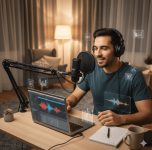Creating a podcast that sounds professional doesn’t necessarily require a high-end studio or costly equipment. In 2025, advancements in technology have made it possible for creators to produce clear, engaging audio with minimal investment. The key lies in understanding basic audio principles, selecting the right affordable tools, and optimizing your recording environment. By focusing on technique and preparation, even beginner podcasters can deliver episodes that feel polished and immersive.

Understanding the Basics of Audio Quality
Before investing in equipment, it’s important to grasp what constitutes high-quality audio. Clarity, consistency, and minimal background noise are the primary factors. Poor audio quality can distract listeners, reduce engagement, and hurt your podcast’s credibility. Ensuring that your voice is captured cleanly, free from echo and interference, forms the foundation for a professional-sounding podcast. Even inexpensive setups can achieve this if the recording environment and techniques are managed effectively.
Choosing Affordable Microphones
A good microphone is the most important tool for recording a podcast, but it doesn’t have to break the bank. USB microphones are ideal for beginners, offering plug-and-play convenience with solid audio fidelity. Popular options under a reasonable budget deliver clear vocals and reduce background interference. Condenser microphones or budget XLR setups can also work well, especially when paired with affordable audio interfaces. The goal is to capture your voice naturally without distortion, making your episodes pleasant to listen to.
Optimizing Your Recording Environment
Even the best microphone can’t compensate for poor acoustics. Choosing a quiet, small room with minimal reflective surfaces significantly improves audio quality. Soft furnishings like curtains, carpets, and cushions absorb unwanted echoes. If external noise is unavoidable, simple solutions like recording during quiet hours, using portable acoustic panels, or creating a makeshift sound booth with blankets can help. Small adjustments in the environment often yield dramatic improvements in clarity and overall listening experience.
Leveraging Free and Low-Cost Software
Recording software plays a crucial role in producing clean audio. Free programs like Audacity or GarageBand allow creators to capture, edit, and enhance recordings without additional cost. These tools provide essential functions such as noise reduction, volume normalization, and trimming. More advanced but still affordable options, like Reaper or Adobe Audition, offer features like multitrack editing and audio restoration. Understanding basic audio editing techniques ensures that your podcast sounds professional, regardless of the gear used.
Techniques for Clear Recordings
How you speak and position yourself relative to the microphone can greatly impact audio quality. Maintaining a consistent distance from the mic, speaking clearly, and using a pop filter to reduce plosive sounds all enhance clarity. Monitoring audio levels during recording helps prevent distortion or clipping. Recording in short segments rather than long continuous takes allows for easier editing and ensures each section is consistent in tone and volume. Attention to these small techniques often outweighs expensive equipment in achieving high-quality results.
Remote Recording Solutions
Many podcasters collaborate with guests remotely, which presents additional challenges for maintaining quality. Tools like Zoom, Riverside.fm, or SquadCast offer high-quality remote recording capabilities. These platforms allow each participant to record locally while syncing tracks, preserving audio fidelity even over internet connections. Combining these recordings in editing software ensures that both hosts and guests sound crisp, professional, and balanced.
Post-Production Enhancements
Editing and post-production are where a podcast truly comes to life. Simple adjustments like equalization, compression, and noise reduction enhance clarity and listening comfort. Background music, intro/outro jingles, and subtle sound effects can be added to elevate production quality without overwhelming the main content. Even modest setups can benefit from these enhancements, making episodes more engaging and enjoyable for listeners.
Creating Professional Podcasts Without Breaking the Bank
By combining thoughtful preparation, affordable gear, and careful editing, podcasters can produce high-quality audio without expensive investments. Attention to microphone choice, recording environment, and post-production ensures clarity, consistency, and listener satisfaction. Shows like
Podcast LOL exemplify how creativity, technique, and strategic use of accessible tools can produce professional-sounding episodes that captivate audiences naturally.
Conclusion
High-quality podcast audio is achievable without costly equipment by focusing on fundamentals, leveraging affordable tools, and optimizing recording techniques. Understanding acoustics, selecting budget-friendly microphones, mastering free or low-cost software, and applying proper recording methods allow creators to deliver polished episodes that engage and retain listeners. Shows like Podcast LOL prove that audio excellence stems from preparation and technique rather than expense, demonstrating that anyone can produce a professional podcast from home with dedication and smart strategies.


